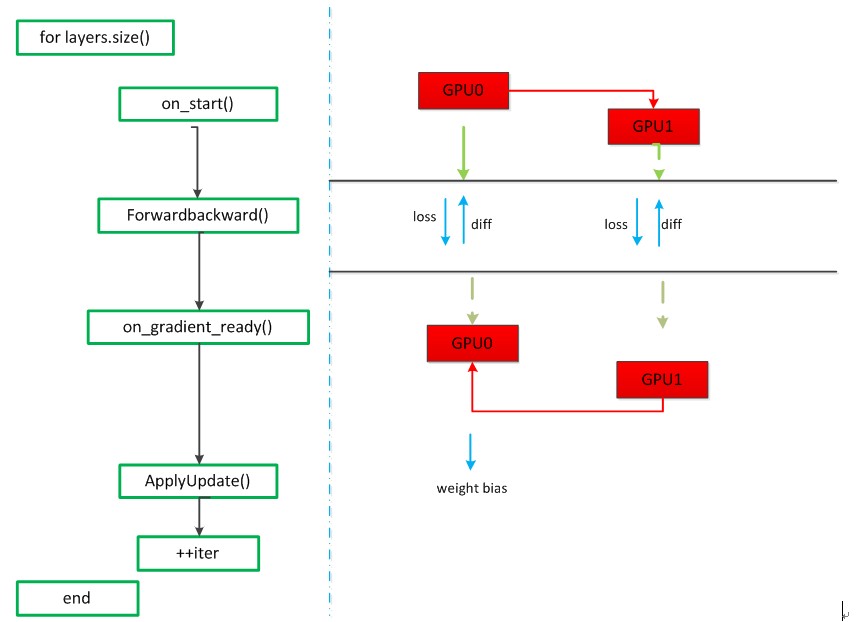Caffe参数交换源码分析
对境准备:对于多个GPU而言,一台机器2个GPU,参数交换的流程图:

参数交换从main()进入train()函数,在train函数中找到对应源码为:
. . . . .
if (gpus.size() > ) {
caffe::P2PSync<float> sync(solver, NULL, solver->param());
sync.run(gpus);
} else {
LOG(INFO) << "Starting Optimization";
solver->Solve();
}
因为GPU的个数>1,所以执行sync(solver, NULL, solver->param())和run()函数,首先会执行P2PSync类的构造函数,然后执行run()函数,run函数的代码如下:
void P2PSync<Dtype>::run(const vector<int>& gpus) {
vector<DevicePair> pairs;
DevicePair::compute(gpus, &pairs);
SolverParameter param(solver_->param());
vector<shared_ptr<P2PSync<Dtype> > > syncs(gpus.size());
// Build the GPU tree by finding the parent for each solver
for (int attempts = ; attempts < pairs.size(); ++attempts) {. . . . . . .
}
for (int i = ; i < syncs.size(); ++i) {
syncs[i]->StartInternalThread();
}
solver_->Solve();
for (int i = ; i < syncs.size(); ++i) {
syncs[i]->StopInternalThread();
}
}
在run()函数中,首先会执行compute()函数,该函数的作用是产生GPU Pairs,GPU Pairs的含义是[parent:child],对于2个GPU而言,GPU Pairs为[-1:0],[0:1],默认根GPU的parent是其本身。然后通过一个for循环构建GPU树,对于2个GPU而言,GPU树如下图所示:

接下来调用一个for循环为每个GPU开启一个线程,值得注意的是for循环是从i=1开始的,即为每个子GPU单独开启一个线程(这里为GPU1开启一个线程),也就是调用StartInternalThread()函数,该函数的代码如下:
void InternalThread::StartInternalThread() {. . . . .
try {
thread_.reset(new boost::thread(&InternalThread::entry, this, device, mode,
rand_seed, solver_count, root_solver));
}. . . . . . .
}
该函数接着会执行entry()函数,该函数代码如下:
void InternalThread::entry(int device, Caffe::Brew mode, int rand_seed,
int solver_count, bool root_solver) {
. . . . . .
InternalThreadEntry();
}
该函数又会去调用InternalThreadEntry()函数,该函数是正式进入迭代运算的入口,代码如下:
void P2PSync<Dtype>::InternalThreadEntry() {
Caffe::SetDevice(solver_->param().device_id());
CHECK(Caffe::root_solver());
Caffe::set_root_solver(false);
// See if there is a defined seed and reset random state if so
if (solver_->param().random_seed() >= ) {
Caffe::set_random_seed(
solver_->param().random_seed() + solver_->param().device_id());
}
solver_->Step(solver_->param().max_iter() - initial_iter_);
}
GPU1调用Step()函数,进入迭代过程,见如下源码:
void Solver<Dtype>::Step(int iters) {
. . . . . . . . . .
while (iter_ < stop_iter) {
. . . . . . . . . .
for (int i = ; i < callbacks_.size(); ++i) {
0_[i]->on_start();
}
const bool display = param_.display() && iter_ % param_.display() == ;
net_->set_debug_info(display && param_.debug_info());
// accumulate the loss and gradient
Dtype loss = ;
for (int i = ; i < param_.iter_size(); ++i) {
loss += net_->ForwardBackward(bottom_vec);//计算loss,一次前后向
}
loss /= param_.iter_size();//loss归一化
. . . . . . .
for (int i = ; i < callbacks_.size(); ++i) {
callbacks_[i]->on_gradients_ready();
}
ApplyUpdate();
. . . . . . . . . .
++iter_;
}
}
整个Step函数的运行如上所示,首先根GPU(GPU0)有整个网络的网络参数,callbacks_.size()指的是GPU树的parent的个数(在这里是1),on_start()函数的作用就是把根GPU(GPU0)的网络参数分发到每一个子GPU(GPU1),GPU1会先进入这个函数,on_start()函数的部分代码如下:
void P2PSync<Dtype>::on_start() {
. . . . . . .
// Wait for update from parent
if (parent_) {
P2PSync<Dtype> *parent = queue_.pop();//取队列中的第一个gpu节点为根gpu
CHECK(parent == parent_);
}
. . . . . .
当执行到queue_.pop()时,会调用blocking_queue.cpp的pop()方法,pop()方法的内容如下:
T BlockingQueue<T>::pop(const string& log_on_wait) {
boost::mutex::scoped_lock lock(sync_->mutex_);
while (queue_.empty()) {
if (!log_on_wait.empty()) {
LOG_EVERY_N(INFO, )<< log_on_wait;
}
sync_->condition_.wait(lock);//如果queue_为空,就一直阻塞。
}
该方法内部有wait()函数,因为此时queue_为空,所以GPU1就会被堵塞,因为GPU0和GPU1是两个线程并行运行,所以GPU0会执行run()函数中的下一步,也就是solver_->Solve(),Solve()函数的代码如下:
void Solver<Dtype>::Solve(const char* resume_file) {
int start_iter = iter_;
. . . . .
//LOG(INFO) <<"This is the sign of the train begin?********Ni****Jian*********"; //test for nijian
Step(param_.max_iter() - iter_);
. . . . .
}
Solve()函数会调用Step()函数进入迭代过程,当GPU0进入on_start()函数后,会把队列中的GPU0出队列,同时会激活被堵塞的GPU1,接下来的on_start()函数代码如下:
. . . . .
// Update children
for (int i = children_.size() - ; i >= ; i--) {
Dtype* src = data_;
Dtype* dst = children_[i]->data_;
#ifdef DEBUG
. . . .
#endif
CUDA_CHECK(cudaMemcpyAsync(dst, src, size_ * sizeof(Dtype),
cudaMemcpyDeviceToDevice, cudaStreamDefault));//每个子GPU把信息传入到根GPU,异步操作
CUDA_CHECK(cudaStreamSynchronize(cudaStreamDefault));//根GPU把信息同步传到各个子GPU
children_[i]->queue_.push(this);
}
#endif
}
在该部分代码中,src指的是GPU0的data(网络参数),dst指的是GPU1的data(网络参数),通过调用cudaMemcpyAsync()函数来放置一个请求,表示在cudaStreamDefault流中执行一次内存复制操作,然后调用cudaStreamSynchronize()等待cudaStreamDefault流中的操作完成后实现流的同步。经过这两个函数后,GPU0完成了把网络参数分发给GPU1,然后children_[i]->queue_.push(this)被执行后,会调用block_queue.cpp文件中的push函数激活GPU0的子GPU,即GPU1,同时把GPU1压入队列,此时队列中只有GPU1。
void BlockingQueue<T>::push(const T& t) {
boost::mutex::scoped_lock lock(sync_->mutex_);
queue_.push(t);
lock.unlock();
sync_->condition_.notify_one();
}
此时,多个GPU的参数分发过程已经完成,接下来GPU0和GPU1并行执行Step()函数的下一步,即:ForwardBackward(),该函数的代码如下:
Dtype ForwardBackward(const vector<Blob<Dtype>* > & bottom) {
Dtype loss;
Forward(bottom, &loss);
Backward();
return loss;
}
该函数的主要作用就是就是计算出loss和梯度diff,然后再接着执行Step()函数中的下一步,即:on_gradients_ready()函数,该函数分为两个部分,第一部分是多个GPU的梯度加和,第二部分是将计算后的梯度传给根GPU(GPU0)。第一部分的代码如下:
void P2PSync<Dtype>::on_gradients_ready() {. . . . . . . .
// Sum children gradients as they appear in the queue
for (int i = ; i < children_.size(); ++i) {
P2PSync<Dtype> *child = queue_.pop();
Dtype* src = child->parent_grads_;
Dtype* dst = diff_;
#ifdef DEBUG
cudaPointerAttributes attributes;
CUDA_CHECK(cudaPointerGetAttributes(&attributes, src));
CHECK(attributes.device == device);
CUDA_CHECK(cudaPointerGetAttributes(&attributes, dst));
CHECK(attributes.device == device);
#endif
caffe_gpu_add(size_, src, dst, dst);
}
第一部分是多个GPU的梯度加和,因为GPU0和GPU1是并行计算的,如果GPU0执行到这里时,会使队列中仅有的GPU1出队列,然后通过调用caffe_gpu_add()函数,将一个GPU的梯度diff直接传给另一个GPU,不需要经过CPU通信,即GPU1把其计算的diff传给GPU0。如果是GPU1执行到这里时,因为GPU1没有子GPU,所以会直接跳过这一部分。第二部分的代码如下:
if (parent_) {
Dtype* src = diff_;
Dtype* dst = parent_grads_;
#ifdef DEBUG
#endif
CUDA_CHECK(cudaMemcpyAsync(dst, src, size_ * sizeof(Dtype), //
cudaMemcpyDeviceToDevice, cudaStreamDefault));
CUDA_CHECK(cudaStreamSynchronize(cudaStreamDefault));
parent_->queue_.push(this);
} else {
// Loss functions divide gradients by the batch size, so to compensate
// for split batch, the root solver divides by number of solvers.
caffe_gpu_scal(size_, Dtype(1.0 / Caffe::solver_count()), diff_);
}
如果是GPU0的话,会执行else,即caffe_gpu_scal(),该函数把得到的之前计算的梯度diff_和除以GPU的个数,来更新梯度。如果是GPU1的话,会执行if的语句,此时和on_start()函数分析类似,经过cudaMemcpyAsync()和cudaStreamSynchronize()函数操作之后,将GPU1中的梯度传送给GPU0,第二部分完成。
接下来根GPU(GPU0)会得到所有的参数信息,会执行Step()函数的下一步,即执行ApplyUpdate()函数,该函数中有一个程序:CHECK(Caffe::root_solver()),会在根GPU中利用梯度下降法更新权重,计算参数,到此为止一次迭代完成,再进入下一次迭代时,根GPU已经保存了所有的网络参数,再继续迭代循环,直至结束。
Caffe参数交换源码分析的更多相关文章
- 认识 Redis client-output-buffer-limit 参数与源码分析
概述 Redis 的 client-output-buffer-limit 可以用来强制断开无法足够快从 redis 服务器端读取数据的客户端.保护机制规则如下: [hard limit] 大小限制, ...
- caffe web demo运行+源码分析
caffe web demo学习 1.运行 安装好caffe后,进入/opt/caffe/examples/web_demo/的caffe web demo项目目录,查看一下app.py文件,这是一个 ...
- 详解SpringMVC中Controller的方法中参数的工作原理[附带源码分析]
目录 前言 现象 源码分析 HandlerMethodArgumentResolver与HandlerMethodReturnValueHandler接口介绍 HandlerMethodArgumen ...
- 性能测试分享: Jmeter的源码分析main函数参数
性能测试分享: Jmeter的源码分析main函数参数 poptest是国内唯一一家培养测试开发工程师的培训机构,以学员能胜任自动化测试,性能测试,测试工具开发等工作为目标.如果对课程感兴趣,请大 ...
- springMVC源码分析--RequestParamMethodArgumentResolver参数解析器(三)
之前两篇博客springMVC源码分析--HandlerMethodArgumentResolver参数解析器(一)和springMVC源码解析--HandlerMethodArgumentResol ...
- 【Spark篇】---Spark中资源和任务调度源码分析与资源配置参数应用
一.前述 Spark中资源调度是一个非常核心的模块,尤其对于我们提交参数来说,需要具体到某些配置,所以提交配置的参数于源码一一对应,掌握此节对于Spark在任务执行过程中的资源分配会更上一层楼.由于源 ...
- 开源网站流量统计系统Piwik源码分析——参数统计(一)
Piwik现已改名为Matomo,这是一套国外著名的开源网站统计系统,类似于百度统计.Google Analytics等系统.最大的区别就是可以看到其中的源码,这正合我意.因为我一直对统计的系统很好奇 ...
- springMVC源码分析--HttpMessageConverter参数read操作(二)
上一篇博客springMVC源码分析--HttpMessageConverter数据转化(一)中我们简单介绍了一下HttpMessageConverter接口提供的几个方法,主要有以下几个方法: (1 ...
- 【MVC - 参数原理】详解SpringMVC中Controller的方法中参数的工作原理[附带源码分析]
前言 SpringMVC是目前主流的Web MVC框架之一. 如果有同学对它不熟悉,那么请参考它的入门blog:http://www.cnblogs.com/fangjian0423/p/spring ...
随机推荐
- 使用NPOI读取Excel数据并写入SQLite
首先,我们来建一个数据库,我们就叫Hello.db(不一定是db后缀,你可以sqlite,sqlite3,db3)都可以作为识别,然后往里面建一个空的表格,如下图所示 然后建一个Excel表格,往表格 ...
- Kafka在windows下的配置使用
Kafka是最初由Linkedin公司开发,是一个分布式.支持分区的(partition).多副本的(replica),基于zookeeper协调的分布式消息系统,它的最大的特性就是可以实时的处理大量 ...
- MOVE - 重定位一个游标
SYNOPSIS MOVE [ direction { FROM | IN } ] cursorname DESCRIPTION 描述 MOVE 在不检索数据的情况下重新定位一个游标. MOVE AL ...
- Linux上进行常用软件的配置
当拿到一个新的linux服务器的时候一般要经过以下5个配置 修改HOSTANME vi /etc/sysconfig/network 修改HOSTNAME和IP的映射 ...
- 完整的node脚手架搭建服务
使用脚手架来搭建node服务,使用到了express架构,不熟悉的可以看下express官方文档:http://www.expressjs.com.cn/ 使用express直接生成服务的文档结构目录 ...
- 非父子组件通过事件传值-vue
1.创建中央事件总线:额外的 new Vue()2.$emit 触发事件3.$on 监听事件 在使用组件的文件中: <template> <div> <x-test :b ...
- 微信小程序开发-入门到熟练(wepy-初级篇)
Title:最近做完了项目,review代码的同时,就想写一篇详细的小程序开发经历,记录自己的项目从0到1的过程 Desc : 小程序从0到1,从小白到完成项目,你需要这样做: step1: 基础知识 ...
- 奇偶选择器:使用odd和even属性实现表格单双行颜色相间和不同
一.奇偶选择器 表格在呈现数据的时候我们为了方便观看,而隔行显示不同的颜色,虽然可以用用类选择器 class实现这种效果,但是未免太过麻烦,为了更加简便地表现这种特殊的效果我们需要用到一种特殊的选择器 ...
- React Native 之组件的定义
App.js 也可以认为是一个组件,那么此文件中能定义多个组件吗? 方式一 import Hello from './Hello' export default class App extends C ...
- Android 如何生成jks签名文件
